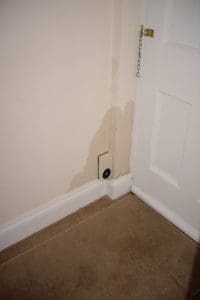Penetrating Dampness
Penetrating dampness usually occurs as a result of external building defects. This can include defective guttering, blocked roof valleys, defective lead work, faulty seals around doors and windows, cracked and/or missing roof tiles, deteriorated pointing and damaged rendering.
In many cases, the source of penetrating dampness is clearly visible and can be repaired quickly and easily. This is why we always recommend conducting regular checks to the external condition of your home. Other sources of penetrating damp are less obvious and can take many years to manifest.
Penetrating damp is generally most visible during or after periods of heavy rain. Some common signs of penetrating damp include:
- Noticeable damp patches (especially on walls which are exposed to prevailing winds)
- Damaged plaster and spoilt decoration on walls or ceilings
- Black mould
- Dampness around windows and door openings
- Sources of damp ingress
- Rainwater penetration
- Staining on walls and the ceiling around chimney breasts
What causes penetrating damp?
External Defects
A number of external defects can cause penetrating dampness including damage to rainwater goods such as gutters or down pipes. Defects to roof coverings, masonry work, pointing and external renders are also common sources of moisture ingress. An external inspection should be included during any investigation of dampness affecting external walls.
Lateral Penetration
This is where the internal floor level is below the external ground level. For example, if the wall is wholly or partially earth retaining. Consequently, moisture from the ground will penetrate laterally into the walls, unless isolated by vertical damp proofing membrane. Usually, penetrating damp can be easily overcome by simply identifying the source of water ingress and tracing it back to its origin. Once located, the appropriate methods of repair can be carried out to prevent further deterioration.
For more information about penetrating damp or to book an appointment with one of our experts, please don’t hesitate to get in touch.
Get in touch with us
For further information get in touch with Biocraft:


